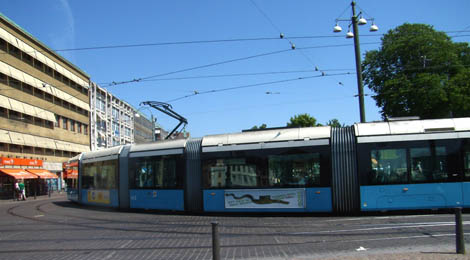 Os tram trains from Gothenburg, Tel Aviv and Valencia already reach the distant suburbs. Today, lithium-polymer batteries have much more capacity than traditional ones. THE new technology, already tried, is to chargethem when braking and when the train moves on electrified lines.
Os tram trains from Gothenburg, Tel Aviv and Valencia already reach the distant suburbs. Today, lithium-polymer batteries have much more capacity than traditional ones. THE new technology, already tried, is to chargethem when braking and when the train moves on electrified lines.
This allows for short trains (two long carriages and three short ones – these to be removed at low-use times) for around 190 seated passengers and 250 standing passengers, to travel on the outskirts of cities and reach a hub in a central part of the city without electrifying the urban area.
Here they run at low speed; between cities at 120km/h. Here, steps open to street level.
Rail sections of the semi-dense suburban and rural railways are electrified and diverted tram trains for a one-way traffic to the neighborhoods of each town or city, up to a hub close to the center, from where it leaves along other avenues to return to the train tracks.
With fast acceleration and braking, the tram train it would allow stops, eg at Patacão and Forum Algarve, on the way to the station in Faro, no additional works. A new branch from Patã de Baixo to Estombar would pass through Branqueira and Avenida dos Descobrimentos in Albufeira, leaving through Camping, AlgarveShopping and Guia to Pêra and from there to Porches and Lagoa.
This alternative avoids costly compensation in cities, by slightly reducing the width of roads and avenues for the passage of rails in the tram train.
Electrification for the tram train it does not prevent the use of old trains (cargo trains) on the rails used by both systems.
The works of the consortium that integrates Tecnovia on the EN125 should really be replaced in the sections already started by the tram-train. Because highway and highway are almost centenary technologies, the current one is the tram train.
The small works needed could be carried out by local builders. Almost all the material purchased would be national, with jobs around here.
By renegotiating the expensive maintenance of the A22, the revenue obtained there would finance the tram train Algarve. Why are a few foreign banks and a local lobby holding back this proposal, contained in the book «Transportes», by the engineers Luís C. Silva, António M. Aguiar and Jack Soifer?
 Author Jack Soifer is the author of the books "Empreender Turismo de Natureza", "Portugal Rural" and "Como Sair da Crise"
Author Jack Soifer is the author of the books "Empreender Turismo de Natureza", "Portugal Rural" and "Como Sair da Crise"


















Comments